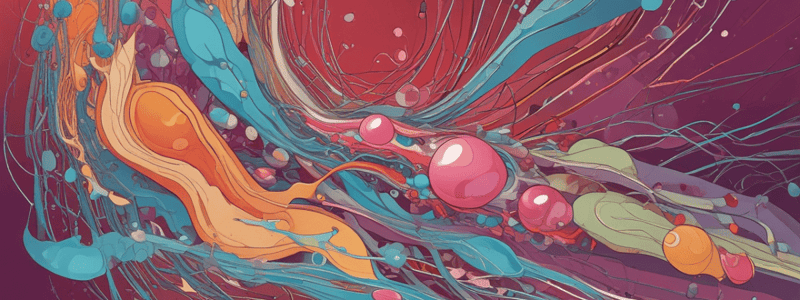Podcast
Questions and Answers
What is the primary role of G-protein in Type II taste cells?
What is the primary role of G-protein in Type II taste cells?
- Activates intracellular pathways
- Facilitates neurotransmitter release
- Mediates signal transduction (correct)
- Triggers cell depolarization
Which of the following is NOT a characteristic of Type III taste cells?
Which of the following is NOT a characteristic of Type III taste cells?
- Involvement in various intracellular pathways
- Activation by ligand binding
- Release of neurotransmitters or ATP
- Depolarization following ligand activation (correct)
What is the endpoint of the Ca2+ signal in Type III taste cells?
What is the endpoint of the Ca2+ signal in Type III taste cells?
- Activation of a G-protein
- Initiation of action potentials in primary sensory neurons (correct)
- Release of Gustducin
- Cell depolarization
Which ligand types selectively activates Type II taste cells?
Which ligand types selectively activates Type II taste cells?
What occurs after the neurotransmitter or ATP is released from Type III taste cells?
What occurs after the neurotransmitter or ATP is released from Type III taste cells?
Type II taste cells respond to sweet, umami, or ______ ligands.
Type II taste cells respond to sweet, umami, or ______ ligands.
The G-protein involved in Type II taste cells is called ______.
The G-protein involved in Type II taste cells is called ______.
Type III taste cells activate various ______ pathways.
Type III taste cells activate various ______ pathways.
In Type III taste cells, the Ca2+ signal triggers ______ or ATP formation.
In Type III taste cells, the Ca2+ signal triggers ______ or ATP formation.
After neurotransmitter or ATP is released from Type III taste cells, the primary sensory neuron ______ and action potentials are sent to the brain.
After neurotransmitter or ATP is released from Type III taste cells, the primary sensory neuron ______ and action potentials are sent to the brain.
Flashcards are hidden until you start studying
Study Notes
Taste Transduction Overview
- Taste sensation involves Type II and Type III taste cells, each functioning through distinct mechanisms.
Type II Taste Cell
- Activated by sweet, umami, or bitter ligands.
- Utilizes Gustducin, a specific G-protein, for signal transduction.
- Involves G protein-coupled receptors (GPCRs) to facilitate the taste signal pathway.
- Depolarization of the cell occurs as part of the signaling process.
Type III Taste Cell
- Ligands stimulate activation of the taste cell directly.
- Engages various intracellular signaling pathways, leading to cellular responses.
- The accumulation of Ca2+ in the cytoplasm is critical, triggering either exocytosis or ATP production.
- Released neurotransmitters or ATP initiate action potentials in primary sensory neurons.
- Sensory signals are transmitted to the brain for taste perception.
Taste Transduction Overview
- Taste sensation involves Type II and Type III taste cells, each functioning through distinct mechanisms.
Type II Taste Cell
- Activated by sweet, umami, or bitter ligands.
- Utilizes Gustducin, a specific G-protein, for signal transduction.
- Involves G protein-coupled receptors (GPCRs) to facilitate the taste signal pathway.
- Depolarization of the cell occurs as part of the signaling process.
Type III Taste Cell
- Ligands stimulate activation of the taste cell directly.
- Engages various intracellular signaling pathways, leading to cellular responses.
- The accumulation of Ca2+ in the cytoplasm is critical, triggering either exocytosis or ATP production.
- Released neurotransmitters or ATP initiate action potentials in primary sensory neurons.
- Sensory signals are transmitted to the brain for taste perception.
Studying That Suits You
Use AI to generate personalized quizzes and flashcards to suit your learning preferences.




